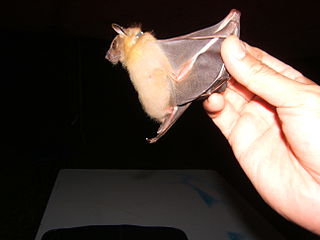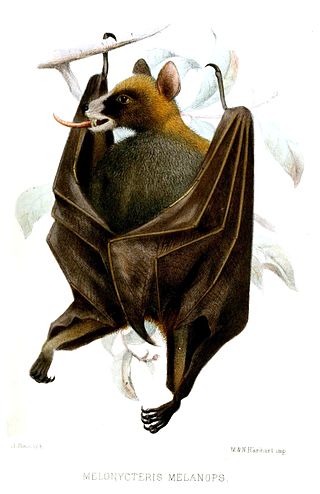
Megabats constitute the family Pteropodidae of the order Chiroptera (bats). They are also called fruit bats, Old World fruit bats, or—especially the genera Acerodon and Pteropus—flying foxes. They are the only member of the superfamily Pteropodoidea, which is one of two superfamilies in the suborder Yinpterochiroptera. Internal divisions of Pteropodidae have varied since subfamilies were first proposed in 1917. From three subfamilies in the 1917 classification, six are now recognized, along with various tribes. As of 2018, 197 species of megabat had been described.
Production of milk (lactation) from a male mammal's mammary glands is well-documented in the Dayak fruit bat and the Bismarck masked flying fox. The term "male lactation" is not used in human medicine. It has been used in popular literature, such as Louise Erdrich's The Antelope Wife, to describe the phenomenon of male galactorrhea, which is a human condition unrelated to childbirth or nursing. Newborn babies of both sexes can occasionally produce milk. This is called neonatal milk and not considered male lactation.

Cynopterus is a genus of megabats. The cynopterine section is represented by 11 genera, five of which occur in Malaysia, namely, Chironax, Balionycteris, Penthetor, Dyacopterus, and Cynopterus. About 30 names for Cynopterus species have been proposed, but only 16 are taxonomically valid forms.

The dayak fruit bat or dyak fruit bat is a relatively rare frugivorous megabat species found only on the Sunda Shelf of southeast Asia, specifically the Malay Peninsula south of the Isthmus of Kra, and the islands of Borneo and Sumatra. There are three species in the genus Dyacopterus: D. spadiceus, D. brooksi and D. rickarti. All are found in the forests of Malaysia, Thailand, and the Philippines. Few specimens of any of the three species exist, due not only to their rarity, but also because they rarely enter the subcanopy of the forest where they can be caught in scientists' nets.

The Neotropical fruit bats (Artibeus) are a genus of bats within the subfamily Stenodermatinae. The genus consists of 12 species, which are native to Central and South America, as well as parts of the Caribbean.

Casinycteris is a genus of bats described in 1910. It currently consists of three species:

Dobsonia is a genus of megabat in the family Pteropodidae. It contains the following 13 species:

Epomophorus is a genus of bat in the family Pteropodidae. They have a distribution throughout Africa.

Melonycteris is a genus of megabat in the family Pteropodidae. Members are found in the Solomon Islands or in the case of the black-bellied fruit bat, in Papua New Guinea.
Micropteropus is a genus of bat in the family Pteropodidae. It contains the following species:

The demonic tube-nosed fruit bat is a species of bat in the family Pteropodidae. It is endemic to Papua New Guinea. The holotype specimen was collected in 1979 on New Ireland, in the Bismarck Archipelago. It was described as a new species in 1983. The range of the species may extend to other islands, however the extent of the range is not presently known.

Brooks's dyak fruit bat is a species of megabat in the family Pteropodidae endemic to Sumatra. It was formerly included as a subspecies of the dayak fruit bat. It is named for Cecil Joslin Brooks, who collected the type specimen near Bencoolen and presented it to Oldfield Thomas.

Thomas's fruit-eating bat, sometimes also popularly called Watson's fruit-eating bat, is a species of bat in the family Phyllostomidae. It is found from southern Mexico, through Central America to Colombia. Its South American range is to the west of the Andes. The species name is in honor of H. J. Watson, a plantation owner in western Panama who used to send specimens to the British Natural History Museum, where Oldfield Thomas would often describe them.

Rickart's dyak fruit bat is a species of megabat in the family Pteropodidae found on Luzon and Mindanao islands, in the Philippines.
The subfamily Cynopterinae comprises 24 species of pteropodid bats distributed exclusively in South and Southeast Asia.











